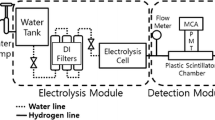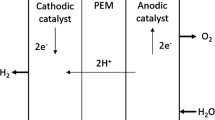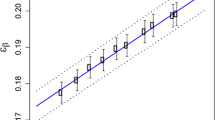Abstract
Developing an online monitoring system becomes useful for continuously detection of tritium in water. A plastic scintillator chamber was used to tritium detection in hydrogen gas produced by a proton exchange membrane electrolysis cell. The fractionation factor (proton selectivity) was estimated as being of 5.41 ± 0.20, and detection efficiency of the plastic scintillator chamber was 4.25 ± 0.22%. For liquid samples, the minimum detectable activity of the developed system was estimated as 655 kBq L−1. Using this online technique for tritium monitoring based on electrolysis is expected to be useful for analysis of large tritiated water bearing samples.





Similar content being viewed by others
References
Chae JS, Kim G (2018) Dispersion and removal characteristics of tritium originated from nuclear power plants in the atmosphere. J Environ Radioact. https://doi.org/10.1016/j.jenvrad.2018.08.007
Querfeld R, Pasi AE, Shozugawa K, Vockenhuber C, Synal HA, Steier P, Steinhauser G (2019) Radionuclides in surface waters around the damaged Fukushima Daiichi NPP one month after the accident: evidence of significant tritium release into the environment. Sci Total Environ DOI. https://doi.org/10.1016/j.scitotenv.2019.06.362
Shen H, Du L, Liu W (2019) HTO activity concentrations in soil and plants in the vicinity of Qinshan Nuclear Power Plant Base. Appl Radiat Isot DOI. https://doi.org/10.1016/j.apradiso.2019.108804
Ohuchi H, Kondo Y, Asakura Y, Kawano T (2011) Tritium measurement in high gamma-ray radiation fields by using an imaging plate. Fusion Sci Technol. https://doi.org/10.13182/FST11-A12571
Herranz M, Alegria N, Idoeta R, Legarda F (2011) Sampling tritiated water vapor from the atmosphere by an active system using silica gel. Radiat Phys Chem. https://doi.org/10.1016/j.radphyschem.2011.06.004
Janković MM, Janković BŽ, Todorović DJ, Ignjatović LM (2012) Tritium concentration analysis in atmospheric precipitation in Serbia. J Environ Sci Health A Tox Hazard Subst Environ Eng. https://doi.org/10.1080/10934529.2012.660039
Dalla Palma M et al (2016) Pulse shape discrimination in polysiloxane-based liquid scintillator. IEEE Trans Nucl Sci. https://doi.org/10.1109/TNS.2016.2530307
Jefanova O, Mazeika J, Petrosius R, Skuratovic Z (2018) The distribution of tritium in aquatic environments. J Environ Radioact, Lithuania. https://doi.org/10.1016/j.jenvrad.2017.11.028
Furuta E, Kato Y, Fujisawa S (2017) Measurement of tritium with plastic scintillators in large vials of a low background liquid scintillation counter: an organic waste-less method. J Radioanal Nucl Chem. https://doi.org/10.1007/s10967-017-5408-6
He T, Wang X, An L, Yang J, Zheng P (2018) An online method to measure tritium production rate of fusion-fission hybrid reactor in CAEP. Fusion Eng Des. https://doi.org/10.1016/j.fusengdes.2018.08.012
Röllig M et al (2013) Activity monitoring of a gaseous tritium source by beta induced X-ray spectrometry. Fusion Eng Des. https://doi.org/10.1016/j.fusengdes.2012.11.001
Köllő Z (2015) A plastic scintillator-based activity monitor for tritiated water in the GBq/ℓ range. Nucl Instrum Methods Phys Res A. https://doi.org/10.1016/j.nima.2015.06.040
Furuta E, Ito T (2018) Prototype apparatus for the measurement of tritium in expired air using plastic scintillator pellets. Appl Radiat Isot. https://doi.org/10.1016/j.apradiso.2017.12.007
Soreefan AM, DeVol TA (2009) Proportional counting of tritium gas generated by polymer electrolyte membrane (PEM) electrolysis. J Radioanal Nucl Chem. https://doi.org/10.1007/s10967-009-0247-8
Aouali FZ, Becherif M, Ramadan HS, Emziane M, Khellaf A, Mohammedi K (2017) Analytical modelling and experimental validation of proton exchange membrane electrolyser for hydrogen production. Int J Hydrog Energy. https://doi.org/10.1016/j.ijhydene.2016.03.101
Furuta E, Kawano T (2015) A plastic scintillation counter prototype. Appl Radiat Isot. https://doi.org/10.1016/j.apradiso.2015.06.035
Bae JW, Lee UJ, Kim HR (2017) Development of continuous inflow tritium measurement in water technology using electrolysis and a plastic scintillator. J Radioanal Nucl Chem. https://doi.org/10.1007/s10967-017-5452-2
Plastino W et al (2007) Tritium in water electrolytic enrichment and liquid scintillation counting. Radiat Meas. https://doi.org/10.1016/j.radmeas.2006.07.010
Soreefan AM, Devol TA (2009) Determination of tritium enrichment parameters of a commercially available PEM electrolyzer: a comparison with conventional enrichment electrolysis. J Radioanal Nucl Chem. https://doi.org/10.1007/s10967-009-0256-7
Singh AN, Ratnakaran M, Vohra KG (1985) An on-line tritium-in-water monitor. Nucl Instrum Methods Phys Res A. https://doi.org/10.1016/0168-9002(85)90141-x
Yin Y et al (2010) Coincidence measurement of 350 μm pitch pixelated CdZnTe detector with LSO PET module. In: Proceedings of IEEE nuclear science symposium and medical imaging conference. https://doi.org/10.1109/nssmic.2010.5874538
Shiva Kumar S, Himabindu V (2019) Hydrogen production by PEM water electrolysis: a review. Mater Sci Energy Technol 2(3):442–454. https://doi.org/10.1016/j.mset.2019.03.002
Funding
This work was supported by the Industrial Technology Innovation Program [Grant Number 2016520101340, Real-time Underwater Tritium Monitoring Technology by Electrolysis), which was funded by the Korea Institute of Energy Technology Evaluation and Planning (KETEP, South Korea); and a National Research Foundation of Korea (NRF, South Korea) grant funded by the South Korean government (MSIP: Ministry of Science, ICT, and Future Planning) [Grant Numbers 2016M2B2B1945083 and NRF-22A20153413555].
Author information
Authors and Affiliations
Corresponding author
Ethics declarations
Conflict of interest
There are no conflict of interest to declare.
Additional information
Publisher's Note
Springer Nature remains neutral with regard to jurisdictional claims in published maps and institutional affiliations.
Rights and permissions
About this article
Cite this article
Bae, J.W., Kang, K.J. & Kim, H.R. Efficiency enhanced electrolysis-based tritium continuous monitor. J Radioanal Nucl Chem 322, 1323–1329 (2019). https://doi.org/10.1007/s10967-019-06836-8
Received:
Published:
Issue Date:
DOI: https://doi.org/10.1007/s10967-019-06836-8




